benzylchloride1
Hazard to Others
  
Posts: 299
Registered: 16-3-2007
Member Is Offline
Mood: Pushing the envelope of synthetic chemistry in one's basement
|
|
The Synthesis of Nickelocene
Synthesis of Nickelocene
Introduction:
Bis(cyclopentadienyl)nickel(II) or nickelocene is a widely studied organotransition metal complex due to its interesting chemical properties.
Nickelocene is an moderately air sensitive organometallic complex that has 20 valence electrons and most of its reactions involve a reduction of its
electron count to 18 valence electrons. Nickelocene is also paramagnetic.
Nickelocene is usually prepared by reaction an alkali metal cyclopentadienide, prepared from an alkali metal and cyclopentadiene with an anhydrous
nickel(II) salt, figure 1. Cyclopentadiene is unstable at room temperature, rapidly undergoing a Diels-Alder reaction with its self to produce the
dimer, dicyclopentadiene. Dicyclopentadiene is used as a source of cyclopentadiene by heating it in a distillation apparatus, which causes it to
undergo a retro Diels-Alder reaction to form cyclopentadiene. Cyclopentadiene can also be deprotonated by potassium hydroxide in dimethylsulfoxide.
The nickel salt still has to be dissolved in an ethereal solvent, 1,2-dimethoxyethane being the best. Diethyl ether also works, but the yields suffer,
this would be the most OTC procedure since the only reagent that is hard to find is dicyclopentadiene. The synthesis described involves the use of
sodium to form the cyclopentadienide ion and tetrahydrofuran as a solvent.
Attachment: Synthetic Scheme.pdf (28kB)
This file has been downloaded 1640 times
Figure 1.
Warning!
Nickel compounds are suspected carcinogens and nickelocene is appreciably volatile at room temperature. Tetrahydrofuran and cyclopentadiene are
extremely flammable. Sodium metal is extremely flammable and ignites spontaneously on contact with water. Dicyclopentadiene and cyclopentadiene are
awful smelling! If the crude product is overheated during sublimation and the hot residue is exposed to air, it can spontaneously ignite! The
synthesis of nickelocene from hexaaminenickel(II) chloride takes a long day; a good stopping point is when the solvent is removed from the crude
product, as long as it is stored under an inert atmosphere.
Experimental:
Unless stated, reagents were technical grade. Balloon grade Helium was used as an inert gas for the synthesis of sodium cyclopentadienide and
nickelocene. Nickel (II) carbonate was dissolved in 6M hydrochloric acid and the solution was filtered and concentrated to dryness, yielding nickel
(II) chloride hexahydrate as a light green solid. This was allowed to air dry for several days. Tetrahydrofuran was analytical grade, distilled from
sodium benzophenone ketyl after refluxing for several hours over sodium metal and benzophenone under an atmosphere of helium until the still pot
turned to a purple color. Figure 2 Depicts the tetrahydrofuran still once the solvent is dry and oxygen free. Toluene was technical grade, refluxed
over sodium metal and distilled. Glassware used for the air sensitive part of this synthesis was dried in a 100 C drying oven for at least 3 hours
prior to use. Diatomaceous earth for filtration was obtained from a swimming pool shop and was dried overnight in a 100 C oven. All ground glassware
was 24/40 standard taper and Dow-Corning silicone grease was used on all joints to prevent the ingress of air, which will rapidly destroy solutions of
sodium cyclopentadienide and the product. Nickelocene can be briefly handled in air, but is best stored under inert atmosphere or better yet in a
flame sealed ampoule
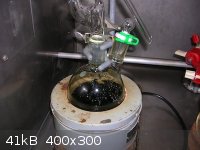
Figure 2. Tetrahydrofuran Still
Hexaaminenickel(II) Chloride
A solution of nickel (II) chloride hexahydrate (10g, 0.042 mole), was dissolved in 30% aqueous ammonia (50mL, excess), forming a blue colored
solution. With stirring, 150mL of acetone was slowly added, precipitating blue colored crystals. The mixture was then kept in an ice bath for 30
minutes to finish the crystallization. The mixture was then filtered using a coarse glass fritted funnel and washed with 3-50mL portions of acetone.
The product was then scraped into a crystallizing dish and allowed to dry on top of a 100 C glassware-drying oven. 7.33g, 75% yield of a light purple
colored solid was obtained. Figure 3 displays pictures taken of a scaled up preparation of this compound.
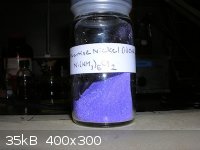
Figure 3. Hexaaminenickel(II) Chloride
Cyclopentadiene
A 250mL single neck flask, a 30 cm distillation column, single piece distillation condenser with a thermometer adaptor, vacuum take-off adaptor and a
250mL receiving flask were dried in 100 C oven for several hours. Dicylopentadiene, (30mL) was placed in a 250mL single neck flask. A 30 cm
fractionation column was then attached to the flask and a combination Liebig condenser-distillation head was attached, along with a vacuum adaptor and
a 250mL flask. A piece of tubing was connected to the vacuum adaptor leading to the back of the fume hood. A thermometer was placed in the thermometer
joint in the distillation head. The dicyclopentadiene-containing flask was heated by an Electrothermal heating mantle at a dial setting of 8. The
condenser was chilled with cold tap water and the receiving flask was chilled in an ice-water bath. After about ½ hour, cyclopentadiene began to
collect in the receiving flask. The cracking process took about 2 hours and the reading on the thermometer did not exceed 35 C due to the high
altitude location of the laboratory, which is 2438 meters above sea level. The cyclopentadiene obtained was used immediately due to its reactive
nature.
Sodium Cyclopentadienide
A 1000mL 3-neck flask, 30 cm reflux condenser, stirrer bearing, Teflon paddle, stirring rod, 60mL pressure equalizing addition funnel, inert gas
inlet, 16 gauge 9 in needle, 20mL syringe and a 50mL graduated cylinder were dried in a 100 C oven for several hours. A Sargent cone drive stirrer was
used to stir the reaction mixture. The reaction apparatus was assembled and flushed with helium using an Schlenk line. A rubber septum was used to cap
the addition funnel. Sodium metal reagent grade, (2.3g, 0.10 mole) was cut into small pieces and washed with dry toluene and placed in the reaction
flask. 50mL of dry toluene was placed in the flask and the flask was heated with a Glascol mantle controlled by a variac set at 70 volts. Once the
sodium melted, the mantle was removed and the mechanical stirrer was started at a fairly fast speed until the sodium was finely divided and then
stopped. Continuation of the stirring will result in the agglomeration of the sodium as it is cooled below its melting point. Magnetic stirring is
ineffective at powdering sodium sufficiently for rapid reaction with cyclopentadiene. The mixture was cooled and the addition funnel was detached and
the toluene was removed with a syringe.
The sodium was washed with several small portions of redistilled Tetrahydrofuran and 160mL of redistilled tetrahydrofuran was measured out with the
dried 50mL graduated cylinder and added to the sodium. The addition funnel was replaced. Freshly cracked cyclopentadiene (15mL, 0.178 mole) was added
to the addition funnel via syringe. The cyclopentadiene was added in portions to the sodium in tetrahydrofuran with a medium rate of stirring. The
solution first turned pinkish and then to a very light purple color as the last of the cyclopentadiene was added. If the flask is not properly flushed
with inert gas, the solution of sodium cyclopentadienide will first be light brown in color and will turn fairly dark purple at the end of the
reaction, it is still useable though, since trace amounts of oxygen cause the formation of these colors. The reaction flask was heated with a heat gun
until liquid started to drip fairly rapidly from the condenser. After 1.5 hours, all of the sodium had dissolved. The solution of sodium
cyclopentadienide was used immediately for the preparation of nickelocene. Figures 4, 5 and 6 depict the solvent still, and cyclopentadiene cracking
apparatus, and Schlenk line and the reaction apparatus at a later stage in the synthesis.
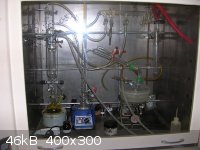
Figure 4. Cyclopentadiene and Tetrahydrofuran stills
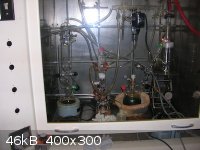
Figure 5. Reaction apparatus, Schlenk filter and tetrahydrofuran Still.
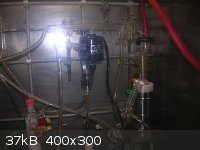
Figure 6. Stirrer and Schlenk line
Nickelocene
After the formation of the solution of sodium cyclopentadienide, the stirrer was stopped and the hexaaminenickel(II) chloride (14g,
0.060mole) was then added through the joint that held the addition funnel in several portions. The addition funnel was replaced with a rubber septum.
The flow of inert gas was increased during this process to prevent the ingress of air. A purple solution of the coordination complex resulted and
ammonia evolution began. The solution was then slowly warmed with a heating mantle. A large amount of ammonia gas was produced during this process.
The mixture was then heated at a slow reflux for a total of 2 hours. A dark green solution of nickelocene resulted, figure 7.
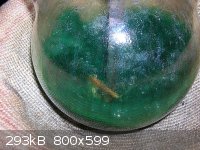
Figure 7. Solution of Nickelocene
An oven dried Schlenk filter was prepared with a 1-inch layer of oven-dried diatomaceous earth and a septum was used to plug the top
female joint. An oven dried 500mL 3-neck flask was attached to the lower male joint. An adaptor with a stopcock was attached to one of the side necks,
and a glass stopper was used to plug the remaining neck, Dow Corning grease was used on all joints. The flask was evacuated with a high vacuum pump
from the lower adaptor and flushed with helium through the upper stopcock three times, figure 8.
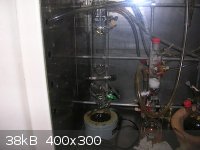
Figure 8. Schlenk Filter
The flow of helium was increased and the condenser and stirred were removed. A 75 degree transfer adaptor was attached to one of the
side necks of the reaction flask and the solution was poured into the Schlenk filter under a stream of helium. The septum was replaced on the Schlenk
filter and a vacuum was applied to the receiving flask, a clear solution of nickelocene collected in the flask. Due to the evaporation of solvent
under vacuum, large needle like crystals of the product formed. Several 20mL portions of redistilled tetrahydrofuran were transferred via syringe to
the Schlenk filter to wash the remaining product out of the diatomaceous earth. The vacuum was disconnected and the flask was filled with helium and
the Schlenk filter was removed. The Schlenk filtration can be skipped and the solvent removed and the product directly sublimed out of the resulting
solid. The product is harder to purify by this method since the inorganic salts are finely divided and tend to stick to the product if one is not
careful. A large football shaped magnetic stir bar was added and the solvent was removed under vacuum with stirring. The mixture was heated in a water
bath after most of the solvent was removed. A liquid nitrogen trap was used to collect the solvent, figures 9 and 10.
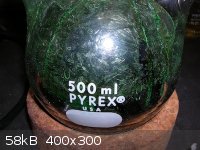
Figure 9. Nickelocene Crystals
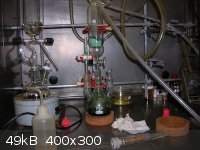
Figure 10. Schlenk filtration
After the residue appeared dry, the flask was heated in a warm water bath under vacuum for about ½ hour to remove any remaining
solvent and dicyclopentadiene. Helium was admitted to the flask and a cold finger condenser was used to replace one of the stoppers for the
sublimation step. The flask was then evacuated and filled with helium three times to remove any traces of oxygen and put under high vacuum. Cold water
was used to cool the cold finger condenser and the flask was heated in an oil bath kept at about 80 C. After about 20 minutes, a noticeable amount of
nickelocene had sublimed on to the condenser, figure 11. After several hours, the flask was cooled and filled with helium and the cold finger
condenser was removed and the green crystals of nickelocene were scraped into a small Schlenk flask. This flask was evacuated and filled with helium 3
times for temporary storage, figure 11. The sublimation process was repeated multiple times and product that sublimed into the upper walls of the
flask was scraped off so that it could be sublimed onto the cold finger condenser. The sublimation takes approximately 2 days on this scale, but
requires minimal attention. A yield of 8.5g of nickelocene was obtained. The theoretical yield was 9.5 g and the resulting percentage yield was 90%.
The product sublimed without melting in a capillary tube sealed under vacuum. The product was sealed under vacuum in 4 glass ampoules for permanent
storage, figure 13.
Figure 11. Sublimation of product
Figure 12. Sublimed crystals of nickelocene
Figure 13. Ampoules of product
An infrared spectrum was taken of the product in the form of a mineral oil mull using a Perkin Elmer 1310 dispersive infrared
spectrophotometer and KBr plates, figure 14. An addendum containing the actual infrared spectrum will be made once I scan the spectra using a scanner.
Note, the infrared spectrum in this photo is not of the product!
Figure 14. Perkin Elmer 1310 dispersive infrared spectrophotometer, NOTE: the infrared spectrum in this picture is not of nickelocene.
Is there any way that I could upload the rest of the pictures for this post, I ran out of attachments.
References
1. Angelici, Robert J. Girolami, Gregory S. Rauchfuss, Thomas B. Synthesis and Technique in Inorganic Chemistry, 3rd Edition. University Science
Books, 1999.
2. Barnett, K. W. J. Chem. Educ. 1974, 51, 422.
3.Brenner, Eric. Chetcuti, Michael J. Ritleng, Vincent. Preparation of a N-Heterocyclic Carbene Nickel(II) Complex. J. Chem. Educ. 2008, 85,
1646-1648.
4. Eisch, John J. King, Bruce. Organometallic Syntheses, Volume 1. Academic Press, 1965.
5.Jolly, William L. Inorganic Syntheses, volume XI, Chapter 4, The Deprotonation of Weak Acids with Potassium Hydroxide: Applications to the Synthesis
of Organometallic Compounds. McGraw Hill, 1968.
6. Wilkinson, G. Pauson, P. L. Birmingham, J. M. Cotton, F. A. J. Am. Chem. Soc. 1953, 75, 1011.
[Edited on 3-1-2012 by benzylchloride1]
[Edited on 3-1-2012 by benzylchloride1]
Amateur NMR spectroscopist
|
|
|
bahamuth
Hazard to Others
  
Posts: 384
Registered: 3-11-2009
Location: Norway
Member Is Offline
Mood: Under stimulated
|
|
Wish I had the setup to do this, wanted to do it for a long time.
Anyways, it seems you are missing a few figures/pictures though...
Awesome stuff!
Any sufficiently advanced technology is indistinguishable from magic.
|
|
|
zoombafu
Hazard to Others
  
Posts: 255
Registered: 21-11-2011
Location: U.S.
Member Is Offline
Mood: sciencey
|
|
Great post, and those are very pretty crystals. I might have to try making them just so I can stare at them all day!
|
|
|
benzylchloride1
Hazard to Others
  
Posts: 299
Registered: 16-3-2007
Member Is Offline
Mood: Pushing the envelope of synthetic chemistry in one's basement
|
|
| Quote: |
Wish I had the setup to do this, wanted to do it for a long time.
Take a look at the Inorganic Syntheses reference I posted in my initial post; there is a much simpler procedure that requires less sophisticated
glassware. The 1,2-dimethoxyethane can be substituted for diethyl ether, but the yields are much lower.
Anyways, it seems you are missing a few figures/pictures though...
|
| Quote: |
Great post, and those are very pretty crystals. I might have to try making them just so I can stare at them all day!
|
Pictures don't do justice to the color of the crystals, I posted a few references for simpler procedures for synthesizing nickelocene that may be
easier for many members as long as they can obtain dicyclopentadiene. The procedure in Inorganic Syntheses works best with a mixture of
1,2-dimethoxyethane and dimethylsulfoxide, but I have substituted diethyl ether and got acceptable, but much lower yields. This would probably be the
best method for many on this forum and does not require a Schlenk filter since an aqueous work up is used.
Here are the missing figures, I ran out of space with the number of pictures in my first post.
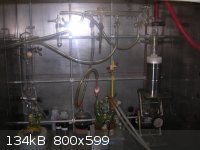
Figure 11. Sublimation of the Nickelocene
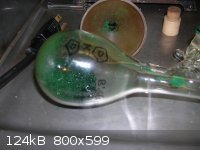
Figure 12. Temporary storage in Schlenk flask
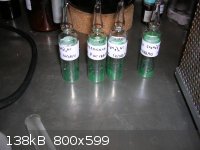
Figure 13. 8.5g of product
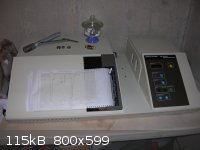
Figure 14. 1310 infrared spectrophotometer, NOTE: the spectra on the instrument is not the product, a addendum will be added as soon as I can turn the
spectrum I have into a PDF file.
[Edited on 4-1-2012 by benzylchloride1]
[Edited on 4-1-2012 by benzylchloride1]
Amateur NMR spectroscopist
|
|
|
Lambda-Eyde
National Hazard
   
Posts: 857
Registered: 20-11-2008
Location: Norway
Member Is Offline
Mood: Cleaved
|
|
Very nice to see that you decided to do a write-up, benzylchloride. Once again you make me envious of your skill and apparatus (especially the PE 1310
 ). I have a similar solvent still, but without an integral condenser and without a
port for transferring solvent with a cannula. This could however be fixed with either a suitable adapter or getting a glassblower to modify it. I
doubt I can justify the purchase (or glassblower commisioning) for a Schlenk filter. Additionally, those are hard to find (in fact I've never seen a
used one with European taper sizes). ). I have a similar solvent still, but without an integral condenser and without a
port for transferring solvent with a cannula. This could however be fixed with either a suitable adapter or getting a glassblower to modify it. I
doubt I can justify the purchase (or glassblower commisioning) for a Schlenk filter. Additionally, those are hard to find (in fact I've never seen a
used one with European taper sizes).
I find this synthesis to be an interesting future project - can I substitute the nickel salt for, say anhydrous CoCl<sub>2</sub> or
FeCl<sub>3</sub> to make the analogues? If I first decide on buying some dicyclopentadiene I'll have to prepare several metallocenes.
Their historical importance justifies their synthesis on its own, not to mention the training in airfree methods. Oh, and if anyone is looking for
cannulas, septums and syringe needles, Laboy glass stocks it - look in the "Accessories" catalog.
For pictures, I always use an external host. I prefer majhost.com, because the design is really simple and lets you catalog your pictures, plus they
never "disappear" like with photobucket or imageshack.
Why did you seal the ampoules under vacuum, instead of inert gas? Seems like a weird thing to me, when you open them air would flush into the
ampoules, plus the significant vapour pressure of Ni(Cp)<sub>2</sub> makes it sublimate under the low pressure, coating the walls and
whatnot...
Oh - and I love the use of the nickel-ammonia complex. When I first read about your nickelocene synthesis in the "pretty pictures" thread, I started
thinking about how to dry my nickel chloride hexahydrate. Swapping the water ligands for ammonia is truly an elegant workaround, compared to refluxing
NiCl<sub>2</sub>*6H<sub>2</sub>O with thionyl chloride! 
Edit: Obviously a ferrocene synthesis would involve divalent iron, not iron trichloride. A brainfart from my side 
[Edited on 4-1-2012 by Lambda-Eyde]
This just in: 95,5 % of the world population lives outside the USA
You should really listen to ABBAPlease drop by our IRC channel: #sciencemadness @ irc.efnet.org
|
|
|
benzylchloride1
Hazard to Others
  
Posts: 299
Registered: 16-3-2007
Member Is Offline
Mood: Pushing the envelope of synthetic chemistry in one's basement
|
|
I have also prepared cobaltocene, titanocene dichloride and ferrocene by similar methods. Anhydrous cobalt (II) chloride can be made by heating the
salt under vacuum in a 150 C oil bath overnight. Anhydrous iron (II) chloride can be prepared by refluxing iron (III) chloride with chlorobenzene or
with iron powder in THF. I think the chlorobenzene method is in Inorganic Syntheses, not exactly sure where and the iron powder method is in
Organometallic Syntheses volume 1. I recommend the latter for anyone trying to make metallocenes of any of the 1st row transition elements. Take a
look at Inorganic Syntheses volume XI chapter 4; this has some simpler methods for preparing these compounds . I would start with ferrocene first
since it is not air sensitive, and you can get away without the extensive drying precautions since a large excess of potassium hydroxide is used as
the base and removes small amounts of water and also you can use homemade iron (II) chloride tetrahydrate! There is a very similar procedure in
Macroscale and Microscale Organic Experiments 2nd Edition by Kenneth L. Williamson and all you need is a Erlenmeyer flask, rubber stopper and a
separatory funnel. Good luck, these compounds are fun to make, and hope everyone with an interest at least tries to synthesize ferrocene via this
procedure. Diethyl ether can be substituted for 1,2-dimethoxyethane with a lowering of yields, from my experience.
[Edited on 5-1-2012 by benzylchloride1]
Amateur NMR spectroscopist
|
|
|
chemstudent777
Harmless

Posts: 1
Registered: 16-12-2012
Member Is Offline
Mood: No Mood
|
|
There's really no point in taking an infrared spectrum of nickelocene. It's going to look identical to an IR of cyclopentadiene, so it's not really
going to prove anything.
|
|
|
Nicodem
Super Moderator
      
Posts: 4230
Registered: 28-12-2004
Member Is Offline
Mood: No Mood
|
|
Quote: Originally posted by chemstudent777  | | There's really no point in taking an infrared spectrum of nickelocene. It's going to look identical to an IR of cyclopentadiene, so it's not really
going to prove anything. |
Obviously, you did not bother comparing their spectra before posting a reply. Different compounds have different IR spectra and these two are very
different. One is a diene, while the other is aromatic and symmetric. All bond energies are different and consequently their resonance vibrations.
Cyclopentadiene has several different C-H bonds, while there is only one type of C-H bonds in nickelocene. Additionally, nickelocene has a Ni-pi
dative bond.
Compare their spectra:
cyclopentadiene
nickelocene
IR and especially Raman IR are very sensitive tools. They give different spectra not only for slight modifications in the structures, but even in
crystal packing. For example, polymorphs of the same compound give slightly different spectra.
…there is a human touch of the cultist “believer” in every theorist that he must struggle against as being
unworthy of the scientist. Some of the greatest men of science have publicly repudiated a theory which earlier they hotly defended. In this lies their
scientific temper, not in the scientific defense of the theory. - Weston La Barre (Ghost Dance, 1972)
Read the The ScienceMadness Guidelines!
|
|
|
|